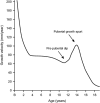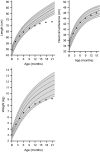Early recognition of growth abnormalities permitting early intervention
- PMID: 23586744
- PMCID: PMC3738943
- DOI: 10.1111/apa.12266
Early recognition of growth abnormalities permitting early intervention
Abstract
Normal growth is a sign of good health. Monitoring for growth disturbances is fundamental to children's health care. Early detection and diagnosis of the causes of short stature allows management of underlying medical conditions, optimizing attainment of good health and normal adult height.
Conclusion: This review summarizes currently available information on monitoring for short stature in children and conditions usually associated with short stature and summarizes the authors' conclusions on the early recognition of growth disorders.
©2013 The Authors. Acta Paediatrica published by John Wiley & Sons Ltd on behalf of Foundation Acta Paediatrica.
Figures







References
-
- Thomas M, Massa G, Craen M, de Zegher F, Bourguignon JP, Heinrichs C, et al. Prevalence and demographic features of childhood growth hormone deficiency in Belgium during the period 1986–2001. Eur J Endocrinol. 2004;151:67–72. - PubMed
-
- Sultan M, Afzal M, Qureshi SM, Aziz S, Lutfullah M, Khan SA, et al. Etiology of short stature in children. J Coll Physicians Surg Pak. 2008;18:493–7. - PubMed
-
- Papadimitriou A, Douros K, Papadimitriou DT, Kleanthous K, Karapanou O, Fretzayas A. Characteristics of the short children referred to an academic paediatric endocrine clinic in Greece. J Paediatr Child Health. 2012;48:263–7. - PubMed
-
- Wit JM, Clayton PE, Rogol AD, Savage MO, Saenger PH, Cohen P. Idiopathic short stature: definition, epidemiology, and diagnostic evaluation. Growth Horm IGF Res. 2008;18:89–110. - PubMed
Publication types
MeSH terms
LinkOut - more resources
Full Text Sources
Other Literature Sources
Medical

